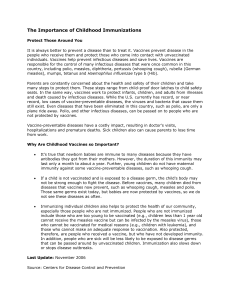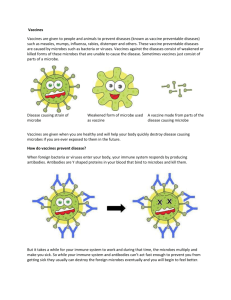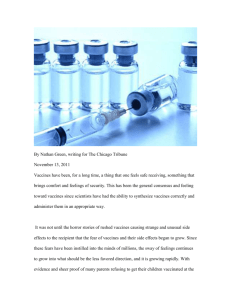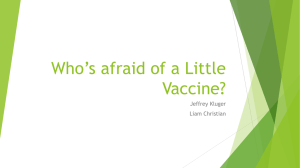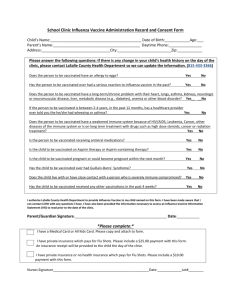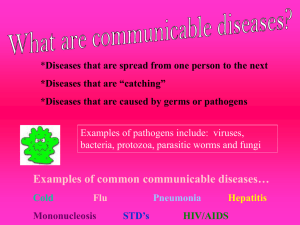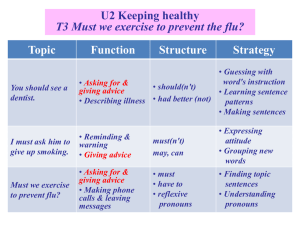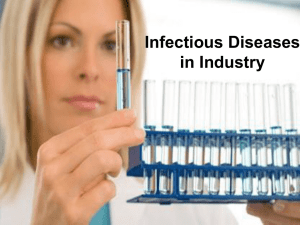Keeping Children Healthy
advertisement
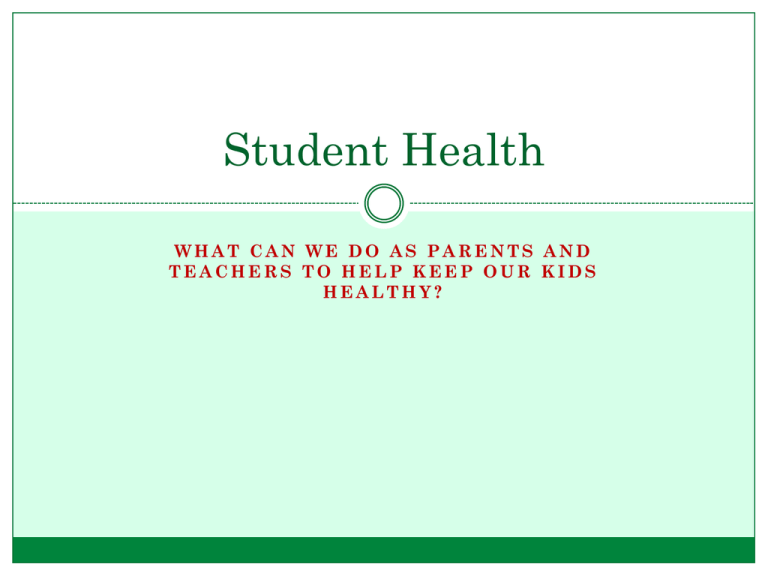
Student Health WHAT CAN WE DO AS PARENTS AND TEACHERS TO HELP KEEP OUR KIDS HEALTHY? Protect Yourself Seasonal colds and flu are a part of life Can be very hard to control, because an individual that has contracted the virus may be asymptomatic for days, but still be contagious Best way to protect yourself and others is through prevention Illness in Children Most common – respiratory infections (cold, croup, strep throat) and ear infections Younger children are at greater risks because they haven’t developed immunity to most infections they are exposed to Chain of transmission 1. Germs – such as virus or bacteria 2. Host – the person who is sick 3. Mode of transmission – anything germs can contaminate (food, counter, desk, our hands) and transmit to a new host 4. New host – the person at risk/susceptible to getting sick How the Chain works Germs are primarily transmitted by direct or indirect contact, airborne, or droplet secretion Germs can survive for hours or even days in the environment, increasing risk of infection Most contagious period is usually when a person doesn’t feel ill Key is prevention Transmission can be stopped by breaking just one link in the chain Droplet Contamination Droplets are produced after coughing or sneezing Can be breathed in by others, can land in their nose, mouth, or eyes which can cause infection Children must be taught to cover their nose and mouth when coughing or sneezing and to wash their hands regularly Maintaining good health Starts with good habits including: eating healthy (plenty of fruits/veggies), getting enough rest (at least 9-10 hours/night), & exercise Good hand washing can help prevent the spread of infection Getting immunizations What can Parents/Teachers do? Ensure all objects and surfaces that children come in contact with are cleaned and sanitized regularly Practice good hand washing and teach the proper techniques to your children Teach your children to cover their nose and mouth when they cough or sneeze Get your children vaccinated and keep the vaccines up to date Good Hand Washing What is the right way to wash your hands? Wet your hands with clean, running water (warm or cold) and apply soap. Rub your hands together to make a lather and scrub them well; be sure to scrub the backs of your hands, between your fingers, and under your nails. Continue rubbing your hands for at least 20 seconds. Need a timer? Hum the "Happy Birthday" song from beginning to end twice. Rinse your hands well under running water. Dry your hands using a clean towel or air dry them. When to stay home from school The American Academy of Pediatrics recommends that parents ask these questions 1. Does your child have a fever? Fever is temp 101 or higher. 2. Is your child well enough to engage in class? If they are too run down to get much out of school then don’t send them. 3. Do you think your child has a contagious illness such as flu or pinkeye? Stay Home If: 1. Fever– temp 101 or higher 2. Diarrhea – keep children home until stool is formed or Dr. gives the okay to return 3. Severe Cough & Cold – serious cough could indicate contagious illness such as whooping cough, viral bronchitis, or croup 4. Vomiting – keep children home if they’ve vomited twice in the last 24 hours Continued 5. Diagnosed with strep throat – do not return to school until 24 hours after first dose of antibiotics 6. Pinkeye (Conjunctivitis) – is contagious, stay home for first 24 hours after treatment begins 7. Rashes – recommended that children not come to school until diagnosed May come to school 1. Headaches that are not causing the child to feel bad overall 2. Earaches are not contagious and they may come if they can concentrate and perform in school 3. Mild cold or respiratory symptoms as long as nasal drainage is clear and cough is mild Flu Vaccine While everyone should get a flu vaccine this season, it’s especially important for some people to get vaccinated. Those people include the following: People who are at high risk of developing serious complications (like pneumonia) if they get sick with the flu. People who have certain medical conditions including asthma, diabetes, and chronic lung disease. Pregnant women. Flu Vaccine People younger than 5 years (and especially those younger than 2), and people 65 years and older. People who live with or care for others who are at high risk of developing serious complications Household contacts and caregivers of people with certain medical conditions including asthma, diabetes, and chronic lung disease. Household contacts and caregivers of infants less than 6 months old. Health care personnel. More information is available at Who Should Get Vaccinated Against Influenza. Why are Childhood Vaccines So Important? Newborn babies- immune to many diseases because of antibodies they got from their mothers. This immunity goes away during the first year of life Young children do not have this "maternal immunity" against some diseases, such as whooping cough. If an unvaccinated child is exposed to a disease germ, the child's body may not be strong enough to fight the disease. Before vaccines, many children died from diseases that vaccines now prevent, such as whooping cough, measles, and polio. Those same germs exist today, but because babies are now protected by vaccines, we do not see these diseases nearly as often. Immunizing individual children helps protect the health of our community Especially those who cannot be immunized Children who are too young to be vaccinated Those who cannot be vaccinated for medical reasons (for example, children with leukemia), Those who cannot make an adequate response to vaccination Are Vaccines Safe? AAP Immunization Web site has been approved as a credible site by the World Health Organization (WHO) Vaccines can cause side effects, most common side effects are mild Vaccine-preventable disease symptoms can be serious, or even deadly. Many of these diseases are rare in this country, they do circulate around the world and can be brought into the U.S., putting unvaccinated children at risk. The diseases that vaccines prevent can still be very serious – and vaccination is the best way to prevent them. Conclusion Get your children vaccinated Teach your children to eat a healthy diet Promote exercise Ensure that your children get enough sleep Teach them to cover their mouth and nose when coughing or sneezing Teach them good hand washing technique and encourage them to wash their hands regularly
